NRAO eNews
Volume 7, Issue 5
30 April 2014
Upcoming Events

2014 Synthesis Imaging Workshop
May 13 - 20, 2014 | Socorro, NM

3rd China-U.S. Workshop on Radio Astronomy Science and Technology
May 19 - 21, 2014 | Green Bank, WV

69th International Symposium on Molecular Spectroscopy
Jun 16 - 20, 2014 | Champaign-Urbana, IL

Transformational Science in the ALMA Era: Multi-Wavelength Studies of Galaxy Evolution
Aug 04 - 07, 2014 | Charlottesville, VA

Revolution in Astronomy with ALMA - The Third Year
Dec 08 - 11, 2014 | Tokyo, Japan
2014 Jansky Fellowships Awarded
The NRAO Jansky Fellowship program provides outstanding opportunities for research in astronomy. Jansky Fellows formulate and carry out investigations either independently or in collaboration with others within the wide framework of interests of the Observatory. The program is open each fall to candidates with interest in radio astronomy instrumentation, computation, and theory, and prior radio experience is not required. Multi-wavelength projects leading to a synergy with NRAO instruments are encouraged. We are pleased to announce that three new Jansky Fellows will be joining NRAO in the fall of 2014.
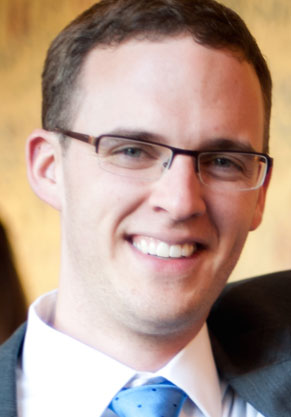
Chat Hull
[click to enlarge]
Chat Hull is completing his Ph.D. at the University of California, Berkeley, where he has spent his graduate career focusing on hardware and astronomy. Along with his adviser, Dick Plambeck, Chat tested, installed, and commissioned the 1 millimeter dual-polarization receiver system at CARMA, and then used the system to perform the TADPOL survey, the largest interferometric survey to date of dust polarization in low-mass protostellar cores. As a Jansky Fellow, Chat hopes to keep a foot in both the technical and the astronomical camps by working to characterize the ALMA polarization system more fully, and by using that system to understand how magnetic fields affect the star formation process at the scales of protostellar envelopes, circumstellar disks, and beyond. He will begin his Jansky Fellowship this fall at the Harvard-Smithsonian Center for Astrophysics in Cambridge, Massachusetts.
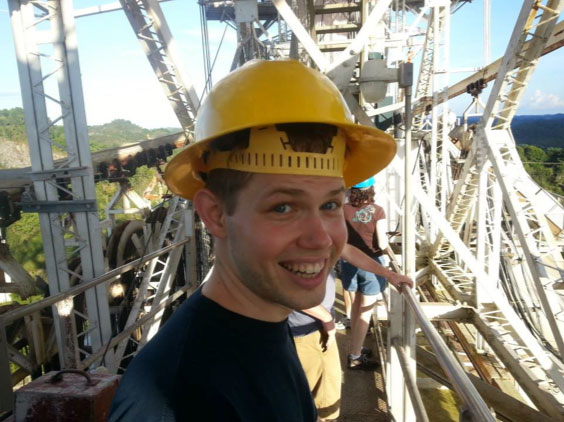
Brett McGuire
[click to enlarge]
Brett McGuire will complete his Ph.D. at Caltech in 2014 in the department of Physical Chemistry. His research focuses on prebiotic astrochemistry at the interface of laboratory physical chemistry and observational astronomy. Brett has experience in laboratory astrophysics and also observational astronomy having observed with the CSO, CARMA, and the GBT. During his tenure as a Jansky Fellow, he plans to explore laboratory studies of astrophysical ices, the likely birthplace of these molecules, in the far-IR (THz) region with the objective of applying these measurements to observations of protoplanetary disks and complex molecular clouds. Brett will spend the first year of his Fellowship between Caltech and NRAO Charlottesville before moving to Charlottesville to complete his Fellowship in 2015. He will collaborate with the University of Virginia in both the chemistry and astronomy departments.
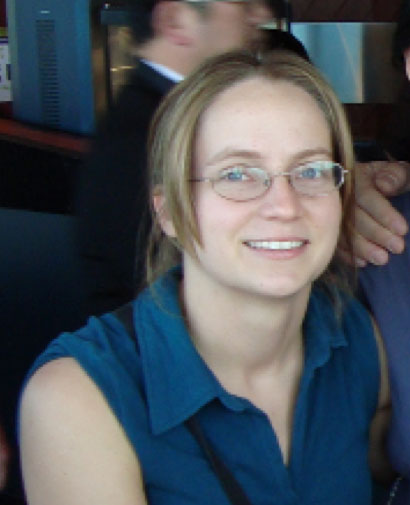
Sarah Burke Spolaor
[click to enlarge]
Sarah Burke Spolaor is currently a postdoc at Caltech, having received her Ph.D. at Swinburne University of Technology (Melbourne, Australia) in 2010. She is an expert on fast radio bursts (FRB). She has extensive pulsar and FRB research experience having used the Parkes radio telescope and the VLA. As a Jansky Fellow, Sarah will undertake research in the topics of radio transients and gravitational-wave astronomy. She will be exploiting the excellent sensitivity and angular resolution of the NRAO interferometric facilities to explore the radio sky on sub-second timescales. She will also be continuing research that aims to discover and characterize electromagnetic emission from binary systems of supermassive black holes in the Universe. Sarah will begin her Fellowship this fall at NRAO in Socorro.
ISM Mass Evolution Probed by ALMA

[click to enlarge]
In a recent publication, Nick Scoville (Caltech), Hervé Aussel (CEA-Saclay) and Kartik Sheth (NRAO) et al examine the use of submillimeter continuum observations for estimating the mass of the ISM (dust + gas) in galaxies. The authors seek an improved understanding of the physics of the cosmic star formation rate density (SFRD) evolution, which increases by 20-30x from the present to a peak at z ~ 2. Is this SFRD evolution driven by the availability of more gas, more efficient star formation, or both? Such measurements are essential for modeling the gas consumption rate over cosmic time.
From their analysis of a sample of local star-forming galaxies, Planck observations of the Milky Way, and high-redshift submillimeter galaxies with CO detections, they find an empirical calibration between the 850 micron submillimeter dust continuum luminosity and the mass of the ISM. They argue that their technique of using continuum observations is superior to molecular line measurements of the ISM content due to the significantly shorter integration time required, less reliance on accurate redshifts, and the avoidance of excitation effects which can alter the CO luminosity-to-gas mass conversion factor. They apply their calibration to stacked images of mass-selected galaxies at redshifts of 0.4, 0.9 and 2, and they include an infrared-selected luminous galaxy sample at a redshift of 2 (see Figure). They find a factor of 6 decrease in the ISM content from redshifts of 0.9-2 (~14%) to redshift of 0.2 (2%) in the mass-selected sample, and a ~50% gas mass fraction for the z = 2 infrared galaxy sample.
ALMA Project Status
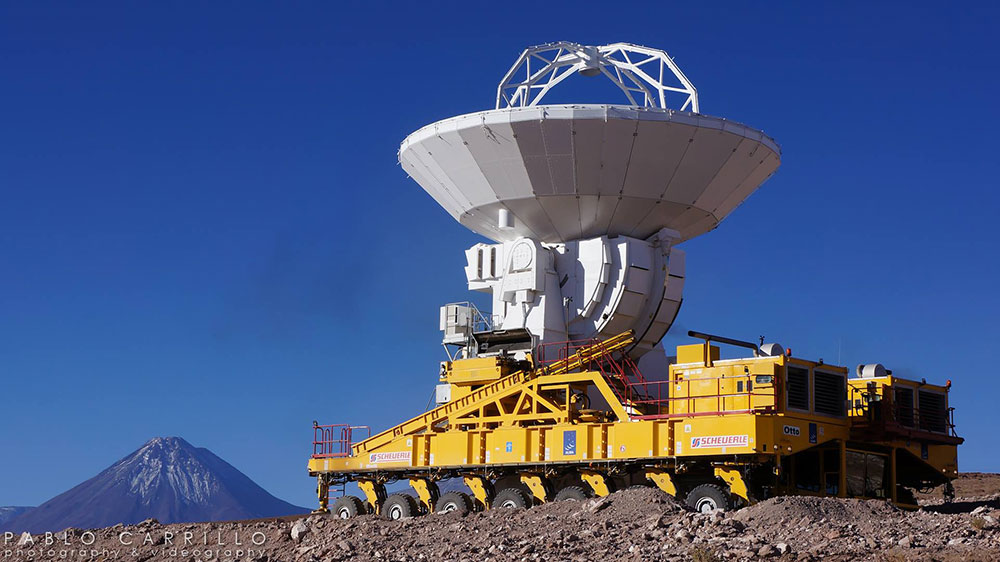
P. Carillo
Antenna PM01 returns to the OSF for nutator outfitting.
[click to enlarge]
All ALMA Cycle 0 Early Science data has been delivered; as the proprietary period for these data expire, the data are made available via the ALMA archive. The archive now has data on over 500 individual sources from 106 proposals. A new casaguide has been published to guide the user through the process from locating and downloading data to production of science-ready images. Twenty-five refereed papers have appeared to date based upon the 41 Cycle 0 datasets delivered to North American PIs.
Cycle 1 Early Science observing continues on ALMA with a new two-week session beginning on Earth Day, 22 April. The array remains in a configuration approximating C32-4, with baseline lengths in the range 20-558m. Of 97 North American projects, 42 have some elements completed, and data has been delivered for 34 of these. Sixteen projects are completed and delivered to the PI. A summary of the Cycle 1 status appeared on the ALMA Science Portal in March. Twelve NAASC staff members are currently reducing datasets.
After a face-to-face meeting, the Pipeline Working Group recommended conditional acceptance of the calibration pipeline to the Joint ALMA Observatory (JAO). The plan is for much of Cycle 2 data calibration to be accomplished by the pipeline.
A new group – titled Extension and Optimization of Capabilities (EOC) – has been formed to lead and increase ALMA's instrumental opportunities. Anthony Remijan leads this group, holding the title of Program Scientist (Extension and Optimization). Catherine Vlahakis became the Deputy Program Scientist (Extension and Optimization), effective 24 March 2014 and will continue in this position for 18 months.
Beginning 1 April 2014, ALMA transitioned to a cadence of two weeks of Early Science observations, followed by one week of focused EOC activity. The current priority is to ensure that the Cycle 2 software and capabilities are ready.
Cycle 2 proposal results were sent to PIs on 9 April, as planned. Overall, 35 proposals received the highest, 'A' rating, including 13 with North American PIs. Just over 300 received a 'B' rating; 104 of these were from North America. Oversubscription was ~4:1 for Cycle 2, which will begin in June. ALMA Regional Center (ARC) staff are preparing execution instructions for the first batches of observations to be made. Cycle 2 will begin with the array in C34-5 configuration, expanding through the austral winter months to its largest configuration. During the austral spring, there will be a period of commissioning the longest baselines for use in a future cycle. When science observing resumes again in December 2014, the array will again be in one of its more compact configurations.
As reported last month, a set of ALMA Development Projects was proposed by the North American ALMA partners and approved by the ALMA Board in March. These include the construction of a prototype 67-90 GHz receivers (4mm, ALMA Band 2), a spectral region rich in deuterium isotopomers of abundant molecules. A meeting was arranged at Arcetri, Italy among interested European, North American and East Asian parties to discuss the challenges posed by this project and to consider choices of engineering design. A combined receiver covering 67-116 GHz in one cartridge was among the discussed alternatives. IRAM engineers presented a design that achieves this using SIS junction technology, but was not clear that this design could be accommodated within an ALMA cartridge. The challenges of realizing a broadband low noise amplifier-based receiver covering such a broad frequency range were discussed. Although developments are promising, this technology does not exist today.
A paper titled The Calibration of ALMA using Radio Sources was published in a recent ESO Messenger by Ed Fomalont et al.
Fourth VLA Data Reduction Workshop
The next VLA Data Reduction Workshop will be held 27 - 31 October 2014 at the NRAO New Mexico Array Science Center (NMASC), in Socorro. As at previous workshops, the intent is to help those with radio astronomy and CASA experience reduce their own VLA data, assisted by our local staff. There will also be presentations on advanced topics by local experts.
We are still working out the exact format, and you can expect more detailed information in the next edition of the NRAO Newsletter. In the meantime, you may want to mark the week of 27 - 31 October 2014 on your calendar.
Computing Cluster Available for Remote Use
The NRAO New Mexico Array Science Center (NMASC), located in Socorro, New Mexico, is pleased to announce the general availability of its 50 node post processing cluster for remote use by investigators. Access is limited to observers with current User Database entries. Observers with projects observed in the current or previous semester will receive priority access.
Documentation describing the process for requesting resources and utilizing assigned resources is online. The computing cluster is intended for VLA and VLBA data processing. The cluster is a finite resource, so access cannot be guaranteed.
NRAO–Green Bank Hosts a Science Fair
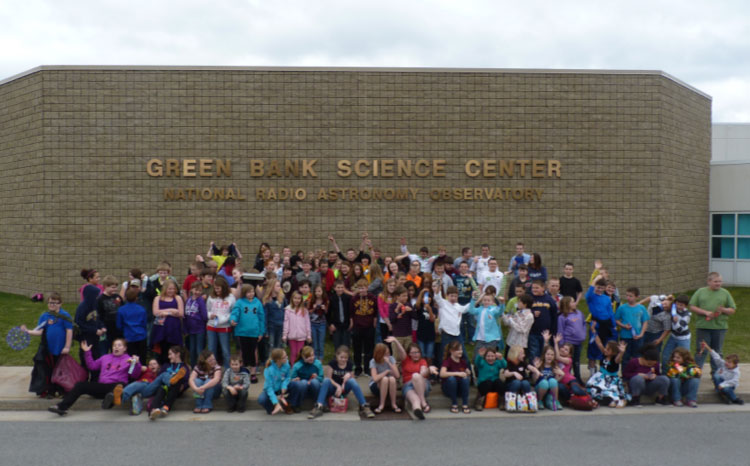
[click to enlarge]
What do different brands of popcorn, sleep deprivation, baking soda and vinegar, raw eggs, and parallel circuits have in common? The Pocahontas County Science Fair, of course!
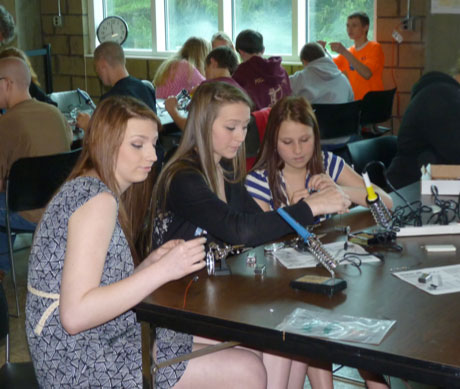
[click to enlarge]
On Tuesday, 8 April, 125 local students in grades 3-12 set up their posters and experiments to participate in a countywide science fair at the NRAO in Green Bank.
Tremendous volunteer support from NRAO staff made the event a huge success. Their efforts began this winter when they ventured out to the schools to motivate students to participate in the science fair and later to assist students in developing “investigable” questions for their projects.
During the fair itself, 23 NRAO staff assisted with project judging and led engaging activities as students cycled through the daylong event. Astronomy activities included the portable Star Lab and an Exhibit Hall scavenger hunt. The GBT Design Challenge was a team-building engineering activity where students used spaghetti, marshmallows, gumdrops, and toothpicks to build a tall structure that could support weight. Finally, the electronics activity involved building play-doh “Squishy Circuits” with the younger students and soldering with the older students.
Parents and family members were invited to the event and popped in throughout the day to visit the projects and participate in the activities. At the end of the day, students cheered that they had a great time. We thank the local Board of Education for allowing Science Fair to be held on a school day and for providing transportation for the students. The science fair was an effective vehicle for fostering community engagement and good will, and a great day for our local young scientists.
Recent Media Releases
 |
NRAO, WVU Expand Broadband Data Network to Bolster Astronomy Research Two of West Virginia’s premier research institutions, the National Radio Astronomy Observatory (NRAO) in Green Bank and West Virginia University (WVU) in Morgantown, have inaugurated a new super high-speed broadband data network to bolster collaboration and scientific research between these two education-focused organizations. Read more… |
 |
Introducing Our New Milky Way Explorer Join the astronomers who are on a quest to understand our Galaxy and the Universe we inhabit with the new Milky Way Explorer. They will tell you about the mysteries they are trying to solve, their favorite objects in space, and their excitement about finally getting to watch our Galaxy's black hole feed. Read more… |
Career Opportunities
Head of the ALMA Department of Engineering (ADE): The Joint ALMA Observatory (JAO) in Santiago, Chile is recruiting for a Head of the ALMA Department of Engineering. The incumbent will be responsible for the management and leadership of the department, for the engineering and technical staff within the JAO, and for the work outcomes from those staff including Systems Integration efforts, the ongoing engineering operations of the array, and overall maintenance issues. The term of appointment is three years.
From the Archives
Ellen Bouton

[click to enlarge]
About this month's photo: The NRAO-hosted 1984 workshop on Physics of Energy Transport in Extragalactic Radio Sources was held, in its entirety, in the upstairs lounge of the Green Bank residence hall. Workshop organizer Alan Bridle says, "It was at a time during which the basic physics of jet propagation and stability, including the role of boundary layer turbulence and mixing, were only just beginning to be appreciated by radio astronomers and astrophysicists although they were well known in fluid dynamics and to engineers dealing with practical jets (e.g. to those trying to reduce noise from jet aircraft engines). Larry Rudnick set up a simple demonstration of several basic phenomena by injecting a gravity-fed 'jet' of a heavy green fluid (a saturated saline solution with added food coloring) into a carafe of water. This simple demo made it easy to observe some of the dynamics of a two-fluid mixing process while adjusting a few parameters, albeit in a regime of velocities, densities, and Reynolds numbers far removed from the astrophysical one owing to budget restrictions and concerns for the safety of the citizens of Pocahontas County."
Observing and discussing the "Jolly Green Jet" are: [Bottom right] Dick Henriksen, Larry Rudnick and Greg Benford. [Bottom left] Alan Bridle, Arieh Königl, Henriksen and Rudnick. [Top left] Bridle and Henriksen. [Top right] Königl, Bridle, and Henriksen.
Thanks to Alan Bridle for caption information. Peter Wilkinson took the original photos, and the composite was created at NRAO for the proceedings volume.
From the Archives is an ongoing series illustrating NRAO and U.S. radio astronomy history via images selected from our collections of individuals' and institutional papers. If readers have images they believe would be of interest to the Archives, please contact Ellen Bouton, ebouton@nrao.edu.


